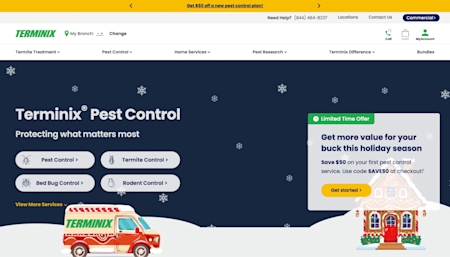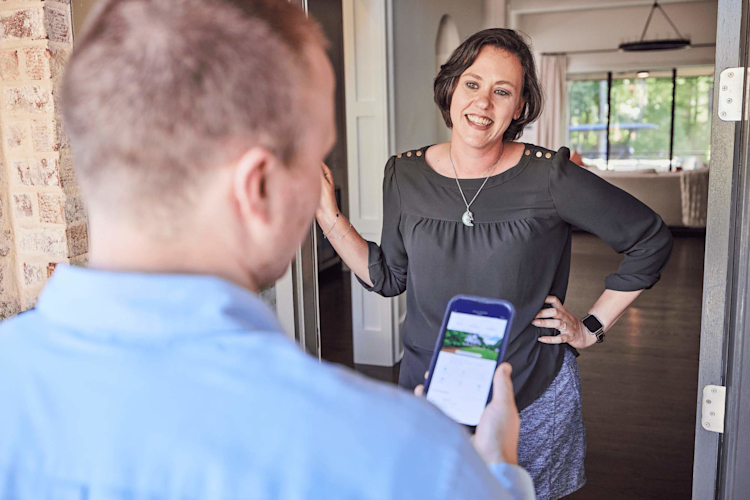10 Best Pest Control Websites (2025 Trends + Tips)

A well-designed, functional website is essential for pest control businesses aiming to attract and retain customers.
With 75% of people judging a business’s credibility based on its website design and user-focused sites converting visits to leads at over 400% higher rates, it’s clear that a strong online presence boosts trust and conversions.
This guide will explore top pest control websites for inspiration and outline practical tips for creating a user-friendly, competitive site in 2025.
The 10 Top Pest Control Websites for Inspiration
Whether you design your pest control website in-house or with a marketing agency, a custom website can really help a pest control company’s online presence.
Great pest control website design does more than just attract visitors it shows your company’s expertise and commitment to service. Pest control experts are key to providing credibility and services to educate and guide customers.
Below, we showcase 10 of the best pest control websites, each exemplifying user-friendly design, effective functionality, and strategies to engage potential customers.
Orkin
Terminix
Rentokil
Aptive Environmental
Ehrlich Pest Control
Green Pest Solutions
Bulwark Exterminating
Truly Nolen
Massey Services
HomeTeam Pest Defense
1. Orkin

Website: www.orkin.com
Why It Stands Out: Orkin’s website has a clean design and professional look and feel, with a simple service menu so visitors can find specific services quickly. A “Get a Quote” button is prominent across the site so visitors can always book an appointment without searching for where to contact them. Clear CTAs are throughout the site to guide user interaction and the path to conversion. Orkin’s initial service is a flushing service, which may increase visible pest activity initially but will help target pests better in follow-up services.
Conversion Features: Online scheduling for quick service booking and live chat so visitors can get instant answers.
2. Terminix

Website: www.terminix.com
Why It Stands Out: Terminix’s website has a clean design and chat functionality. This clean design and easy navigation allow users to access important info and pest solutions.
Conversion Features: Interactive chat for immediate assistance and limited-time offers provide FOMO to visitors, making potential customers engage with the site and move towards conversion. Terminix also offers home services based on pest type, so visitors get comprehensive inspections and ongoing protection from re-infestation.
3. Rentokil

Website: www.rentokil.com
Why It Stands Out: Rentokil’s website has a clean design and a header menu with icons, allowing easy navigation and a better overall user experience. It also has a valuable educational blog, positioning it as a thought leader in its industry. Rentokil also offers comprehensive pest management services for residential and commercial properties.
Conversion Features: Contact options are displayed prominently, chat now is prevalent, and customer reviews and testimonials are easily displayed.
4. Aptive Environmental

Website: www.goaptive.com
Why It Stands Out: Aptive Environmental’s website is focused on eco-friendly pest control with a contemporary design that appeals to the environmentally conscious customer. The homepage is simple and informative, and there is a big “Get Started With Pest Control for $79” button for quick access to services. Aptive is different from competitors by focusing on sustainability. Aptive uses sustainable technologies to provide effective pest control solutions so customers get innovative and reliable pest management for residential and commercial.
Conversion Features: In addition to the offer mentioned above, there is an online chat and a “Get a Quote” button for fast service booking. An eco-friendly message is highlighted throughout for customers looking for green pest control.
5. Ehrlich Pest Control

Website: www.jcehrlich.com
Why It Stands Out: Ehrlich Pest Control’s website has a nice design and offers solutions for residential and commercial customers. It has strong local SEO, because there is a search box to find your local branch so users can easily find nearby services and a clean design that allows users to navigate easily to service options.
Conversion Features: Ehrlich’s website has quick access to service areas, online quote forms, a pest services blog and live chat for immediate customer support. These features convert visitors into customers by making engagement easy and fast.
6. Green Pest Solutions

Website: www.greenpestsolutions.com
Why It Stands Out: Green Pest Solutions' catchy slogan resonates with visitors. The copy is engaging, and the icons highlight its mission to treat pest problems.
Conversion Features: Free estimate request form, online scheduling and blog that educates customers about pest issues. These features engage users and build trust by providing valuable information and easy ways to request services.
7. Bulwark Exterminating

Website: www.bulwarkpestcontrol.com
Why It Stands Out: Bulwark Exterminating’s website features many insects and uses a lot of video content to educate customers about pest control methods for visual learners. Bulwark offers treatments for different pest problems; they select treatments based on the type of pest and environmental conditions.
Conversion Features: Free estimate request and blog with pest control tips. Bulwark’s site is designed for customer engagement. Simple information builds trust so users can decide and convert.
8. Truly Nolen

Website: www.trulynolen.com
Why It Stands Out: Truly Nolen’s website is visually memorable, with its yellow mouse cars and strong branding. It is a fun and user-friendly site with local services, so customers can easily find nearby offices.
Conversion Features: Fast scheduling options, a pest search bar and a local branch finder. These elements combine to convert by providing convenience and a good user experience.
9. Massey Services

Website: www.masseyservices.com
Why It Stands Out: Massey Services’ website may initially seem like a lot of text, but it does have an easy-to-scroll look with clear messaging about pest control solutions. This mobile-optimized website makes UX easier, giving users a good experience on all devices. Massey Services offers termite control solutions and emphasizes the need for customized treatments for termite issues, as displayed in their metadata next to the favicon.
Conversion Features: The “Schedule a Free Inspection” form is on every page, making service requests easy. Combined with a fast service booking process, it makes conversions easy by making contact options very accessible.
10. HomeTeam Pest Defense

Website: www.pestdefense.com
Why It Stands Out: HomeTeam Pest Defense’s website has a corporate feel to it’s design (blue is very corporate color) and detailed information on different pest control solutions in the header. They have a lot of local banches to help with local SEO plus icons of different pest which you can easy scroll through to find your pest rppoblem.
Conversion Features: Users can easily book services and access valuable information, improving the overall user experience.
What Makes a Great Pest Control Website?
A good pest control website should combine function with design to capture user attention and convert. Pest control is a competitive industry, and a good website can set a company apart, generate leads and build trust.
When choosing the right pest control company is important; customers should consider years of experience, innovative pest management solutions, certifications, pesticides, common pest services offered, and the benefits of year-round preventative programs.
Here are our features of a good pest control website.
User-friendly design: A simple and clean layout so users can find services, contact info and CTAs easily. Clear menu options and big buttons reduce friction so customers can find what they need fast.
Fast loading speed: Pages that load fast keep users engaged and reduce bounce rates. Google loves fast sites, so optimizing for speed can improve search rankings and generate more organic traffic. So, it’s a must for attracting organic traffic.
SEO best practices: Implementing SEO techniques like keyword-optimized pages and good meta descriptions increases visibility on search engines. Local SEO helps pest control businesses reach customers in their service areas.
Lead generation tools: Online scheduling, quote request forms and live chat convert visitors into leads. Easy-to-access forms or call-now buttons encourage visitors to take action directly, such as calling your phone number or sending a message.
Visual appeal: High-quality images and clean design elements make it look professional. Consistent branding with colors and fonts reinforces the company’s professional image.
Customer reviews and testimonials: Displaying reviews builds trust and credibility by demonstrating positive customer experiences. Certifications, ratings, social media and testimonials on the homepage give new customers confidence in the service.
Pest control websites can attract, engage, and convert visitors effectively by focusing on these elements.
What Are Some Tips to Improve Your Pest Control Website in 2025?
A good pest control website in 2025 should combine design, lead generation tools and SEO-driven functionality.
As competition grows, pest control businesses should optimize their websites to improve user experience, conversions and local visibility.
Pest control experts can provide valuable insights and services that can make a big difference in website content.
Here are tips to make your pest control website stand out.
1. Ensure mobile responsiveness
Most users search on mobile, so a responsive website is a must.
A mobile-friendly design ensures content, images, and CTAs adjust to any screen size and creates a good experience on smartphones and tablets.
Google also favors mobile-friendly sites in search rankings, so ensuring your website is mobile-responsive can directly impact visibility.
Test for responsiveness across devices to ensure easy navigation, readable text and accessible contact forms for all users.
2. Implement lead generation tools
Good lead-generation tools make it easy for visitors to take action.
Include features like online scheduling, quote request forms and live chat to guide visitors to conversion. For example, placing a “Schedule a Service” or “Call Now” button possible calls to action on the homepage can increase pest control service bookings.
Adding chatbots or live support can give users instant answers and reduce the chances of losing leads.
3. Focus on local SEO
Search Engine Optimization can get your pest control website to attract local (and national) customers.
Optimize with keywords like “pest control [your city]” and claim your Google Business Profile to show up in local search results.
Create service area pages, FAQs and localized blog posts, and encourage customer reviews to boost local SEO.
This targeted approach makes it easy for customers in your area to find and choose your pest services.
4. Use high-quality images and videos
Visual content improves user experience and builds trust.
High-quality images and videos of your team, services and equipment give visitors a better understanding of what you offer.
Videos can also show pest control methods, demonstrate your expertise, and educate clients on pest prevention. Avoid stock images when possible; real photos establish credibility and make your brand more relatable.
5. Optimize website speed
Fast-loading websites keep visitors engaged and improve search rankings.
Pages that take more than 3 seconds to load can increase bounce rates and cost you leads. Use tools like Google PageSpeed Insights to test and improve loading times, focus on compressing images, reduce redirects and enable browser caching.
Optimized speed enhances user experience and SEO performance.
6. Feature customer reviews and testimonials
Showing customer reviews and testimonials builds trust and gets new customers. Add testimonials on the homepage or service pages to reassure visitors about your services.
Positive reviews on Google, Yelp or your website’s review section boosts credibility and SEO. Ask happy customers to leave a review to strengthen your brand and get more business.
These will improve your pest control website and be friendly and competitive in 2025.
How FieldRoutes Can Help Improve Your Pest Control Website
FieldRoutes’ software gives pest control companies the tools to optimize their website for lead generation and customer engagement.
By integrating FieldRoutes’ solutions, businesses can automate tasks, streamline customer interactions and expand their marketing reach for a seamless customer and staff experience. FieldRoutes’ marketing suite, for example, allows targeted campaigns to attract high-quality leads while keeping in touch with existing customers.
The software’s integration capabilities, including API options, also improve operational efficiency by connecting key tools in one platform, reducing duplicate data entry and manual errors.
With FieldRoutes’ marketing tools, pest control companies can deliver content that converts. Automated follow-ups, targeted email campaigns and customer behavior insights make it easier to retain customers and get repeat business. Combined with FieldRoutes’ robust API integrations, these features give a user-friendly, data-driven website experience that builds trust and converts.
FieldRoutes makes website optimization simple and scalable.
It’s Your Turn Now
A good conversion-optimized website is crucial in the pest control industry.
By adding user-friendly web design, SEO and lead-generation tools to your site, you can attract and convert more visitors. Implement the above to make your website better, more attractive and more performing.
Ready to take your pest control website to the next level?
Schedule a free demo of the FieldRoutes Operations Suite to explore solutions tailored to help your business grow.





